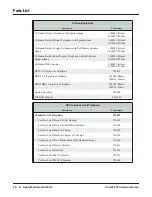
Annex
WIFI SIP terminal for network requirements and recommendations
Voice quality directly is affected by all three QoS quality factors: loss, latency, and jitter.
The following list summarizes the key QoS requirements and recommendations for voice (bearer traffic):
Voice traffic should be marked to DSCP EF per the QoS Baseline and RFC 3246.
Loss should be no more than 1 percent.
One-way latency (mouth to ear) should be no more than 150 ms.
Average one-way jitter should be targeted at less than 30 ms.
A range of 21 to 320 kbps of guaranteed priority bandwidth is required per call (depending on the
sampling rate, the VoIP codec, and Layer 2 media overhead).
Limitations and Factors Affecting Throughput
First and foremost, throughput to the Internet is capped by the ISP and devices upstream of the APs. Also,
802.11 is a shared medium and is limited by other devices connected to the wireless. Therefore, throughput
should always be considered aggregate throughput. Interference (radio, physical, electrical) and the distance
from client device to the Access Point are two major factors that have a negative impact on observed maximum
throughput. Physical obstacles, other wireless networks and even everyday household devices like computers,
microwaves, and televisions increase interference significantly, especially on the 2.4GHz band.
The half-duplex nature of wireless combined with other overhead also means that the actual aggregate
throughput is typically 50 percent or less of the data rate. It is theoretically possible for 802.11n-capable
wireless clients to achieve speeds as high as 100Mbps or more depending on the MIMO capabilities of the
AP and the wireless client. However, wireless clients operating at 802.11b/g/a can cause 802.11n users to
slow to less than 54Mbps because the radio must adjust to the lowest common denominator.
The nature of Wi-Fi technology makes throughput hard to predict. Therefore, network administrators should
maintain reasonable expectations for connection speeds and keep the above factors in mind.



































